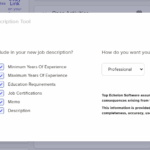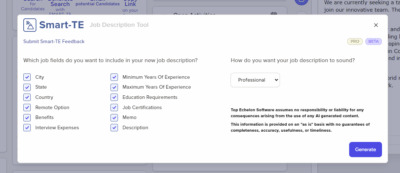Believe it or not, the New Year is upon us! How did it happen so quickly? That’s a topic for another blog post. No, what we want to talk about now is the topic of workforce trends for 2017. Specifically, we want to identify them and discuss how recruiters can take advantage of them.
The workforce is constantly in a state of flux, changing and evolving with the times. As a result, recruiters must also evolve. They must stay one step ahead of emerging employment trends so they can continue providing value to both companies and candidates. Because providing value is the #1 way to not only make placements, but increase your recruiter fees and billings on a year-over-year basis.
Technological workforce trends in the recruiting industry
Ever since the advent of the recruiting profession, search consultants have adapted and evolved. Remember, there was no Internet when the profession started. Technology has certainly played its role in the continued evolution of the profession. Recruiters have been forced to adapt to things such as the following:
- Desktop computers
- The fax machine
- Laptop computers
- The Internet
- Cell phones
- Social media
- Text messaging
- Smartphones
- Tablet devices
These technological innovations have had a huge impact on the workforce and, by extension, recruiters over the years. While technology continues to advance, it’s not doing so at the breakneck pace it has been. As a result, the current employment trends have more to do with human behavior and workforce demographic trends than technological innovation. That’s good news for recruiters. That’s because as a whole, search consultants are more skillful when it comes to human behavior than they are with technology. (No matter what the younger generation brings to the table.)
Trends in the workforce and how to take advantage of them
Before you can take advantage of the top workforce trends, you must identify them. While there are plenty of trends operating within the marketplace right now, we’ve identified five of the biggest. As you’ll see, the majority of them are continuing trends. It’s not like they just sprang up all of a sudden. They’ve been in motion for quite some time now, and they appear to be gaining even momentum.
We’ve broken these trends down into two parts: what the trend actually is and what recruiters can do to take advantage of it. Let’s begin, shall we?
Workforce trend #1: “Job hopping” becoming even MORE prevalent
It used to be that “job hopping” was bad. Staying at one company for years and years was deemed to be good. My, how times have changed. Now if you stay at a company for more than five years, you’re practically labeled as “risk-averse” and “unwilling to challenge yourself.” You can partly thank the younger generations for this seismic shift.
The average tenure for employment for everybody, regardless of age, is about four and a half years. But for the Millennials? You’re lucky if they stay in the same job for three years. These people want to move up the ranks and then move on to the next stop in their career. Forty years and a gold watch? Please. They’re looking for two years at a time and a golden parachute.
What recruiters can do:
Are you kidding? This is great news for recruiters! More people changing jobs more often means more job orders to fill means, which means more placements. This is the best math equation ever. If you have a superstar Millennial candidate in a talent-starved niche, you should theoretically be able to place that person over and over and over. That’s because after two or three years, they’ll be itching for their next opportunity . . . and you’ll have just the job!
This continuing trend affords recruiters the chance to position themselves as a “career coach.” Recruiters have been trying to use this approach since the profession was created. However, it’s tough to be the “career coach” for somebody who works at the same company for 25 or 30 years. But now, with all of this “job hopping”? This is a great opportunity for recruiters to market and brand themselves more effectively.
Workforce trend #2: Continued scarcity of top talent
It’s most definitely a candidates’ market right now. In fact, it’s been a candidates’ market for quite a few years now. One of the reasons for this is that there’s a skills gap in the United States. According to CNNMoney.com, there were 5.8 million job openings in June of this year. By way of contrast, there were only 2.3 million job openings during the worst part of the Great Recession. No matter what the unemployment rate is, top talent is always in demand. Companies always want to hire the very best candidates, and these days, those candidates are scarce. Increasingly, the majority of people do not have the skills and/or experience that organizations are seeking.
What recruiters can do:
This . . . is a no-brainer. That’s because this is what recruiters DO: they find top talent when that talent is scarce. Not only do they find it, but they present the opportunity and then recruit the talent. The kind of superstars that companies are seeking are not applying to online job postings. Scarcity of talent, especially top talent, is a recruiter’s best friend. (Even more so than his dog, because the dog is not going to eat if his master doesn’t make placements.) This trend has existed in the workforce for the past few years, and it appears as though it’s been intensifying with each passing year. Every recruiter worth their salt should be using this trend to help them make more placements and increase their billings.
Workforce trend #3: Difference in what appeals to top talent
It’s about a lot more than the money and compensation these days. After all, superstar candidates—those at the very top of their profession—can expect to receive multiple offers that include the very best in compensation. In other words, they’re getting a bunch of offers that are all roughly the same in that area. What they’re looking for is something to “break the tie” and help them to make their decision. This is why the following factors are increasingly important:
- Company culture
- The organization’s mission statement and vision for the future
- How much the company “gives back” to the community
- Flex time
- Opportunities for advancement
- Access to training and skills development
- Health and well-being programs
The more that the younger generation (i.e., Millennials) saturate the workforce, the more this trend will continue to prevail and most likely evolve further.
What recruiters can do:
Recruiters should take a strategic two-pronged approach to attracting the best talent. The first prong is educating their clients about exactly what the top candidates in the marketplace are seeking. Companies can not give these candidates what they want if they do not know what these candidates actually want. Recruiters can position themselves as a trusted advisor and an expert on top talent. You’ve heard of the “horse whisperer.” You can be a “candidate whisperer.” If you can speak the language of the top candidates and your clients can’t, then your clients will increasingly rely upon you to recruit them.
On the candidate side, the more you know about what they want, the better you can recruit them. You can push all the right buttons and close the deal at the opportune time. The offer stage is the most precarious stage of the recruiting process. Your clients should be relying upon you to extend the offer and secure the offer, which means you’re selling it using everything that appeals to candidates now—not what appealed to them 10 or 15 years ago.
Workforce trend #4: Emphasis on the candidate and employee “experience.”
There are two sides to this particular issue. The candidate experience pertains to hiring, while the employee experience pertains to retention. Organizations need to hire well and retain even better, and providing the best experience possible is now the way to do it. There are things that companies hardly ever considered. But consider this. When a candidate has a bad experience during an organization’s hiring process, they:
Never apply for a position with the organization ever, ever again.
Tell their friends and colleagues about their bad experience, which in turn dissuades those people from ever applying for a position with the company.
Do both of these things.
Of course, the only thing as important as hiring superstars is keeping them once you hire them. That’s why organizations are now bending over backwards to provide the kind of experience that will do just that. This is especially the case with the best employees. That’s because they are exactly the type of passive, grade-A candidates that other organizations want to hire! If they’re not engaged, then they are at risk for leaving. As a recruiter, you know this better than anybody.
What recruiters can do:
First, you can continue to educate clients about the reality of the marketplace. Once again, if you know what top candidates want—not just in a job but also in their experience—then you’re better positioned to attract and hire them. There are many companies that are not in this position. They need the expertise of an experienced recruiting firm to help provide the type of experience necessary to hire the best candidates. When it comes to your firm, you can absolutely provide a stellar experience to those candidates. Not only are you branding your firm in their minds, but you’re also branding your clients, as well.
As far as retention is concerned, you should be educating your clients on the importance of the employee experience. As for companies that are NOT your clients? Well, if their poor employee experience results in disgruntled employees . . . then so be it. Chances are good that you have plenty of exciting new career opportunities for them to explore.
Workforce trend #5: The continued rise of the blended workforce
Ever since the Great Recession, there’s been a shift in the employment marketplace. This shift involves the way in which organizations view hiring employees on a temporary or contract basis. Before the Great Recession, they would utilize contractors only every once in a while. Now, contingent workforce trends are more prevalent, mainly due to the flexibility and cost savings that contract workers offer.
In the blended workforce model, companies maintain a small core group of traditional, direct hire employees. That core is surrounded by an outer ring of contractors. These contractors are often responsible for day-to-day tasks and critical projects. The outer ring can grow quickly when extra help is needed, which is especially important when the peak is sudden and unexpected. That ring can be reduced just as quickly when the need passes. Hence, the flexibility. The monetary savings arises when the company does not have to deal with all of the costs associated with hiring a worker on a direct hire basis.
What recruiters can do:
The main thing that recruiters can do is incorporate contract staffing into their desk or their agency’s business model. It’s actually pretty simple to do. Statistics show that 80% of contract job orders come from a recruiter’s existing direct hire clients. So the business is there. You just have to ask for the contracting job orders. And yes, then you’ll need candidates to fill those job orders, but you might be surprised at how many candidates are willing to work on contract.
Then there’s the choice of recruitment back office solutions. That is also pretty simple to navigate. Recruiters can use contract staffing services to handle the legal, financial, and administrative details. When you do that, you don’t have to worry about any of it. All you have to do is fill the job order with a candidate and collect the placements checks when they arrive. Oh, and cash the checks, too. Can’t forget that.
Past and future workforce trends
Overall, this past year was a good one for recruiters. Was it as good as the year before? That depends upon which recruiter you ask.
However, when viewing the profession as a whole, the last several years have been good ones for recruiters—2013, 2014, 2015, and 2016. It’s been during those years that the economy has emerged from the Great Recession and companies have been more than willing to ramp up their hiring. It’s also during these years that the workforce trends listed above began to appear and manifest themselves.
These have been and continue to be trends that benefit recruiters and the recruiting profession. Will they last forever? Of course they won’t. Every candidates’ market eventually comes to an end, and when it does, there will be future workforce trends and new challenges to go along with them.
But until then? Enjoy the candidates’ market and take advantage of the workforce trends above. Turn them into more placements, greater billings, and a better year in 2017 than you had in 2016.








